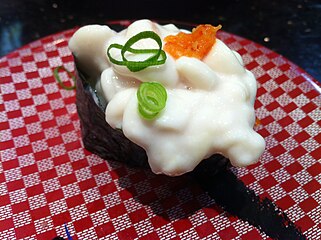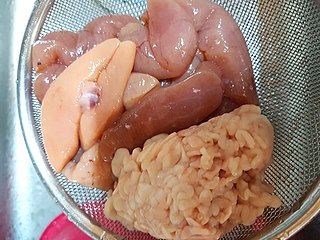Milt

Miltis theseminalfluid offish,mollusks,and certain other water-dwelling animals which reproduce by spraying this fluid, which contains thesperm,ontoroe(fish eggs). It can also refer to the sperm sacs or testes that contain the semen.
Milt as food[edit]
Milt (sometimes spelledmelt[1][2]) orsoft roealso refers to the malegenitaliaof fish when they contain sperm, used as food. Many cultures eat milt, often fried, though not usually as a dish by itself. As a food item, milt is farmed year-round in nitrogen tanks, throughhormoneinduction orphotoperiodcontrol.[3]
InIndonesian cuisine,the milt (calledtelur ikan;fish egg) ofsnakeheadandsnapperis usually made intokariorwoku.
InJapanese cuisine,the testes ( bạch tửshirako'white children') ofcod(tara),anglerfish(ankō),salmon(sake),squid(ika) andpufferfish(fugu) are eaten.
InKorean cuisine,the milt (이리iri) ofAlaska pollock,cod,blackmouth angler,bogeo,andsea breamare eaten.
InRomanian cuisine,the milt ofcarpand other fresh water fish is called "Lapți" (from the Latin wordlactes) and is usually fried.
InRussian cuisine,herring milt (молока, "moloka" ) is pickled the same way as the rest of the fish, but eaten separately, sometimes combined withpickled herringroe. Variouswhitefishsoft roes are usually consumed fried and it is an inexpensive everyday dish.
InSicilian cuisine,the milt oftunais called "lattume" and is used as a typical pasta topping.
InBritish cuisine,codsoft roes are a traditional dish, usually fried in butter and spread on toast.
Chemical composition[edit]
Herring milt is 82.5% water, 2% fat, 16.7% protein, and 2% ash for fish with 21% milt. Cod milt is 82% water, 1.1% fat, 14.5% protein, and 1.8% ash.[4]
-
Japaneseshirako(cod milt)gunkanmaki
-
Smeltmilt
See also[edit]
References[edit]
- ^"Two quick recipes for Melts (aka soft herring roes)".The Fish Society.4 August 2018.Archivedfrom the original on 30 June 2022.Retrieved2 August2023.
- ^Dick Lauder, Thomas (1877) [First published 1825].Lochandhu: A Tale of the Eighteenth Century(Second ed.). Elgin: James Watson. p. 28.Retrieved2 August2023– via Google Books.
A mass of herring melts, tinged with the streams of claret, had fallen into his hair, and this, added to his temporary stupor, had led to the Doctor's mistake.
- ^"Vegetal Production".Gases in Agro-food processes.2019.doi:10.1016/B978-0-12-812465-9.00013-X.
- ^Batista, I (2007). "By-catch, underutilized species and underutilized fish parts as food ingredients".Maximising the Value of Marine By-Products.




